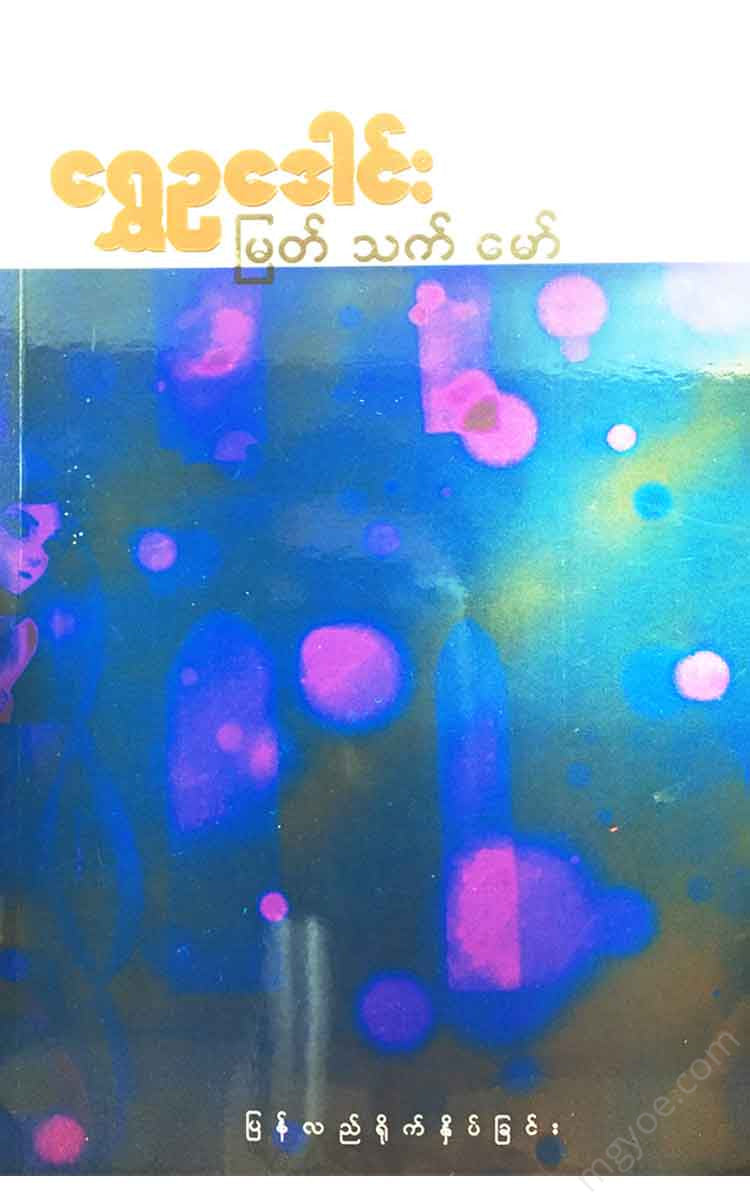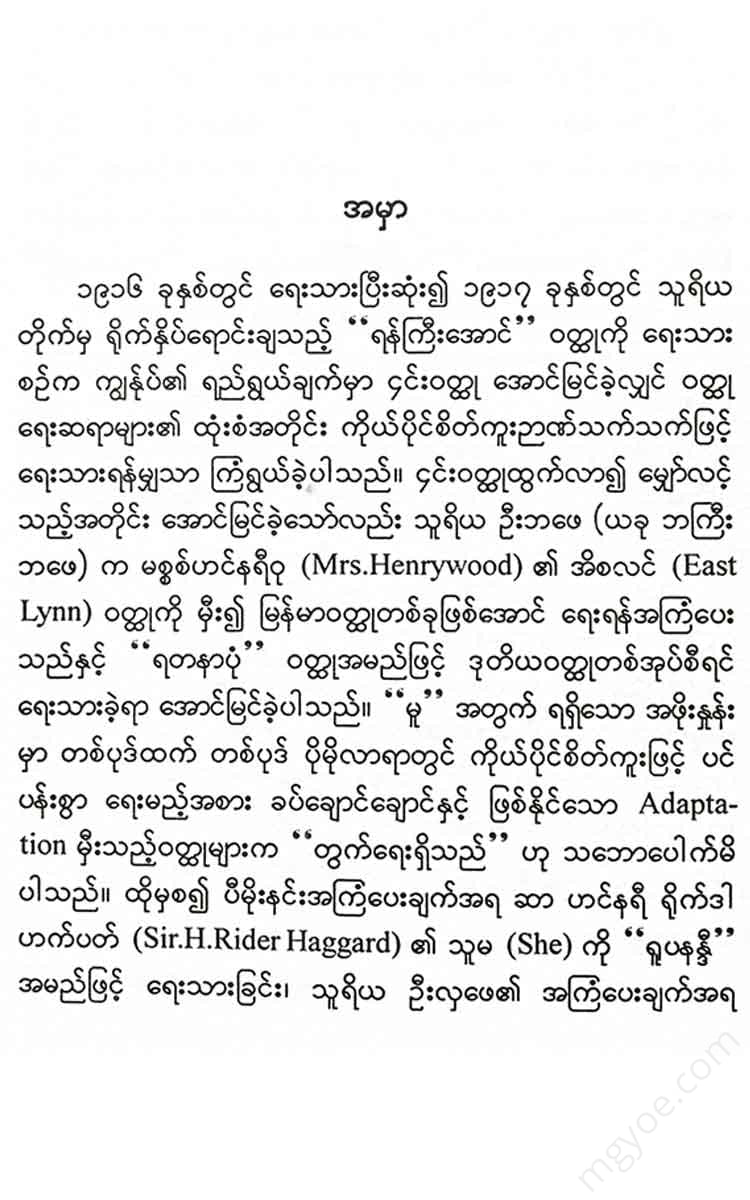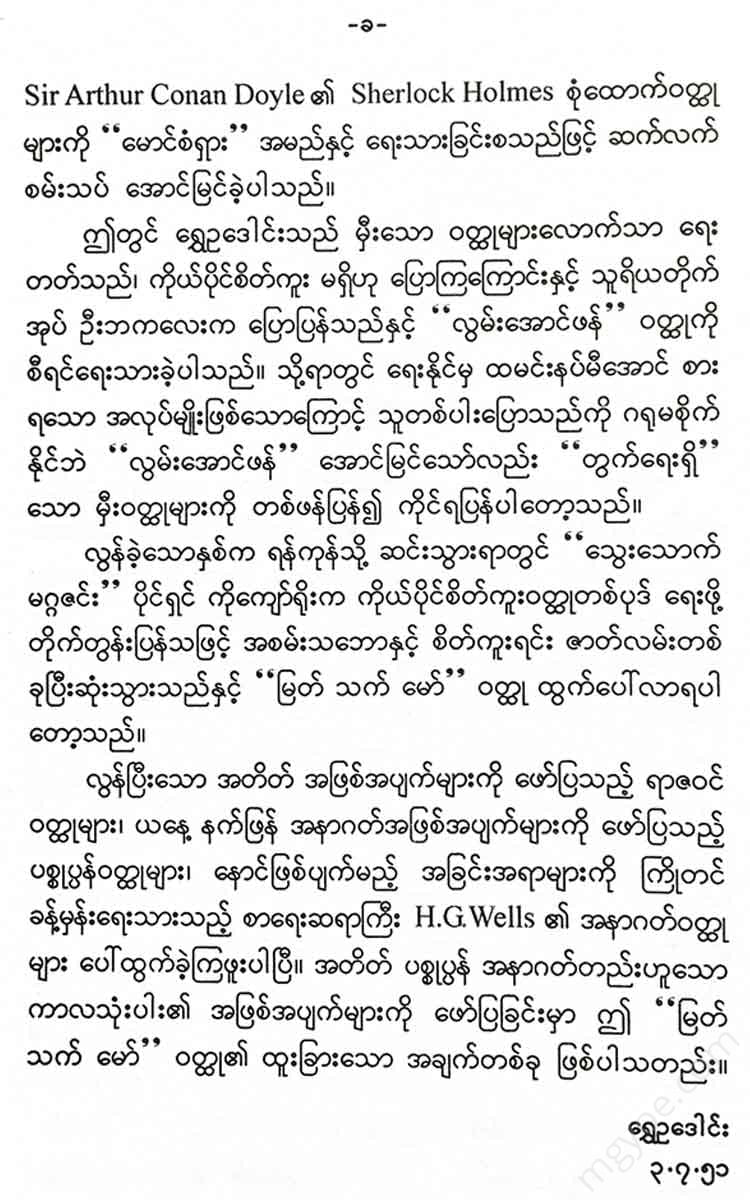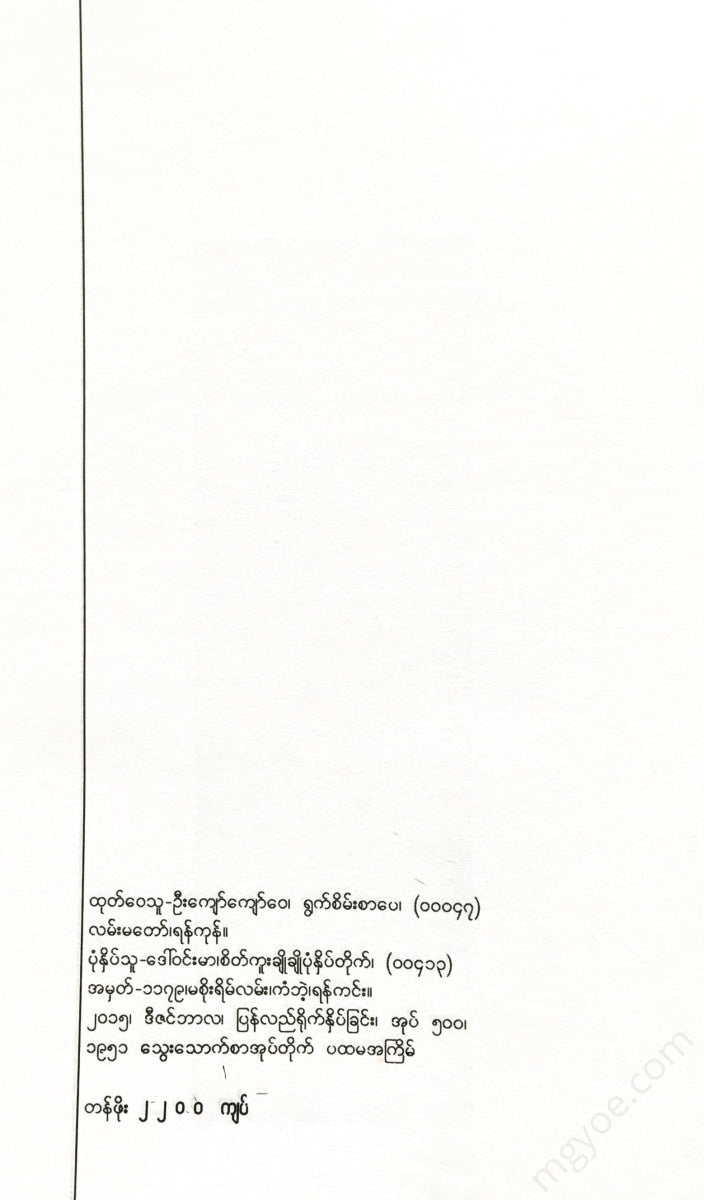စိတ်ကူးချိုချိုစာပေ
Golden Peacock - Myat Thet Maw
Golden Peacock - Myat Thet Maw
Couldn't load pickup availability
Chapter (1)
When you look up from a distance, you can see a green, lush, and lush green area where the sky meets the earth. As you approach, you can see more than 100 or 200 houses inside a large fence of thorn bushes about a palm high, built in all directions. There is a single road that curves in a non-centered direction from east to west or south to north. On either side of the entrance, there are thorny gates with thorn branches and thorns tied to them. There are also guardhouses that are so thick that not only bedbugs but also cockroaches and lizards cannot hide. On the east side, there is a monastery. Not far away, among the pagodas that are only a few stumps left, there is a new, white pagoda. On the west side, under a group of old trees, there is an old temple with a dilapidated roof and a broken wall, and not far away, there are nine new tombs surrounded by fragments of old gold paper and pieces of bamboo. On the south or north side, there is a lotus flower covered with a betel leaf, with a ruby placed among the sapphires, or a drinking pond with a single lotus flower emerging from the clear blue betel leaf. These are the features of the rural villages along the Shwebo area, which in ancient times boasted of being the land of fish.
What you see from a distance is nothing more than the reflection of the sunlight on the glass panes that are often placed on pagodas or "monasteries" in temples.
After entering from the east gate, I heard the voices of the elders who were answering the prayer “Ha-na-na-na-na” and the students who were chanting the auspicious words “Baw-dewa-putta, O-nat-thar” long enough for the monk to hear, and then I reached the top of the village, and then I heard the sounds of the looms “Jaw-galin-chauk”, “Mi-htoo-re, let the cows go free”, and the voice of the mother asking her daughter to herd the cows. “Shwe-hlaing-roh "Nita, take the king out of the coffin and go to the farm," the old woman's voice telling her granddaughter, "You can't help but smile, even if you're a guest who comes occasionally."
In the middle of the village, on one side of the road, two large courtyards, neatly swept and swept, with no trash or dung, face each other. There, two large houses with four-sided roofs made of palm leaves, called Bo Ein, stand opposite each other in the middle of the courtyard. The buildings such as cowsheds, horse stables, grain barns, straw huts, stoves, and huts, as well as the various equipment surrounding each house, such as carts, carts, water carts, horse-drawn carts, and large water storage pots, all of which are in a state of confusion, indicate that this is a place where the villagers live.
Facing each other on the middle of the village road and looking at the way they were built, one might think that the two owners of the house were brothers. In fact, the owners of the house were U Kyaw Ho and U Phan Phan, who were not brothers or relatives, but were wealthy men who competed with each other in their pursuit of glory. One built a large house, the other built a large house; one bought a good horse, the other bought a good horse, the other built a pagoda; one gave alms, the other gave alms; one built a well and a shrine, the other a temple and a pond, and so on.
Since the beginning, they had a desire to compete with each other in honor. If a son was born to U Kyaw Ho, U Phong would also have a son, and if a daughter was born to U Phong, U Kyaw Ho would also have a daughter. Thus, nature encouraged the rivalry between the two.
U Kyaw Hoe's son and daughter were named Maung Tha Myat and Ma Ngwe Nyi, while U Myint Hlaing named his son and daughter Maung Lu Maw and Ma Shwe Yi. There was another factor that helped them. Not long after the birth of their daughter, their wives died, and they lived as hunters for a long time. They looked after each other's heads, and when U Kyaw Hoe married for the second time, U Myint Hlaing also started looking for a new wife.
The children continue to compete for honor from their parents. For example, Tha Myat and Lu Maw practiced at the monastery, while Ngwe Nyi and Shwe Yi competed in reciting Mangal Sutta and Namek Kara in the village school. When U Kyaw Hoe named his daughter Ngwe Nyi, U Pham Ngai named her Shwe Yi, it was in a sense a competition for honor.
Tha Myat and Ngwe Nyi, Lu Maw and Shwe Yi are from the Burmese military, and although they are not very beautiful, they have a Burmese face, unlike other Burmese who look like Chinese, Karen, or Muslim. In other words, they do not have a prominent nose that makes them look like Muslims. They do not have a pale skin that makes them look like Chinese. They do not have a fair skin that makes them look like a general. If they are fair, they are only medium-sized and have a rather heavy and rugged appearance. However, they have a firm and firm face and eyes that show understanding and understanding, which are only found in the Burmese military. When you look at each one, it is not enough to praise how beautiful they are, but the true talent and spirit of these four Burmese people are clearly visible on their faces, as if they are shouting. Therefore, it seems that it was a conflict area between U Aung Zeya and the left-wing MP Sundara.
As someone with a reasonable level of local knowledge in Burma, I would like to tell you a personal story. In addition to having pure Burmese blood and a Burmese appearance and face, the people of Shwebo are also two or three years ahead in terms of knowledge. This means that an eight-year-old Shwebo child has the same intelligence as a 10 or 11-year-old child from another region. Although they are behind in terms of modern knowledge, they are lagging behind in political and other competitions, but they are a real group in terms of intelligence. One day, when modern knowledge and foreign knowledge spread evenly throughout the Union, the people of Shwebo are likely to rise up in one camp.







